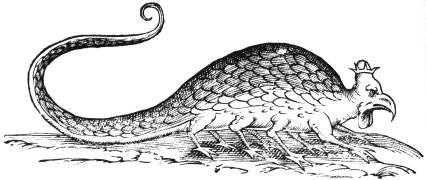 It has been called the king of snakes. The enigmatic basilisk is a marvel of ancient ingenuity. What other wondrous creature could be concocted in such a way that no normal person could see it without succumbing to its deadly power. Around 78 AD, Pliny the Elder wrote Naturalis Historia (Natural History), one of the few works to have survived from the Roman era intact. He describes the catoblepas, a cow-like creature with the ability to kill whomever looks at it, then goes on with the following (translated from Latin):
It has been called the king of snakes. The enigmatic basilisk is a marvel of ancient ingenuity. What other wondrous creature could be concocted in such a way that no normal person could see it without succumbing to its deadly power. Around 78 AD, Pliny the Elder wrote Naturalis Historia (Natural History), one of the few works to have survived from the Roman era intact. He describes the catoblepas, a cow-like creature with the ability to kill whomever looks at it, then goes on with the following (translated from Latin):There is the same power also in the serpent called the basilisk. It is produced in the province of Cyrene, being not more than twelve fingers in length. It has a white spot on the head, strongly resembling a sort of a diadem. When it hisses, all the other serpents fly from it: and it does not advance its body, like the others, by a succession of folds, but moves along upright and erect upon the middle. It destroys all shrubs, not only by its contact, but those even that it has breathed upon; it burns up all the grass too, and breaks the stones, so tremendous is its noxious influence. It was formerly a general belief that if a man on horseback killed one of these animals with a spear, the poison would run up the weapon and kill, not only the rider, but the horse as well. To this dreadful monster the effluvium of the weasel is fatal, a thing that has been tried with success, for kings have often desired to see its body when killed; so true is it that it has pleased Nature that there should be nothing without its antidote. The animal is thrown into the hole of the basilisk, which is easily known from the soil around it being infected. The weasel destroys the basilisk by its odor, but dies itself in this struggle of nature against its own self.
Leonardo da Vinci added that it was the smell of a weasel’s urine that killed the basilisk and often the weasel itself.
Throughout history, many writers have commented on the basilisk, each adding their own twists to the story, but none as unusual as the birth of the basilisk. These deadly creatures are often confused and even intermixed or indistinguishable from the cockatrice, another just as deadly monster. But while the cockatrice is reportedly the egg of a rooster incubated by a snake or toad, the basilisk is just the opposite. It is supposedly the egg of a snake that is sat on by a rooster until hatching while the star Sirius is ascending in the night sky. In the Northern Hemisphere (as in ancient Rome and Greece), the rise of Sirius meant the coming of summer. As a result, it’s said that the basilisk takes on some characteristics of the rooster, including a crown on its head. Other scholars had decided the birthing was a ridiculous notion, but still they agreed regarding the creatures deadly abilities. Here are just a few of their ideas/additions:
- It was not the gaze itself that killed, but rather the corruption of the air between the basilisk and the victim.
- Its breath was a poisonous fume.
- The basilisk could breathe fire.
- It could kill with the sound of its hiss.
- Touching a basilisk would kill. This ability also included accounts where the victim might die if the basilisk touched something the victim was also touching, like a sword or spear.
- It grew in size (considerably) depending on the author and is described as a much larger creature.
- On some coats of arms, the basilisk is given legs and wings, as to be a small dragon.
 Roosters could kill a basilisk, either by claw or by call. This inspired travelers in Medieval times to sometimes carry roosters with them while traveling, to protect them against the basilisk.
Roosters could kill a basilisk, either by claw or by call. This inspired travelers in Medieval times to sometimes carry roosters with them while traveling, to protect them against the basilisk.- The caw of a crow could kill it.
- The creature would die if it saw its own reflection in a mirror.
So, why was there such a fascination with this creature? Ancient alchemists believed that the basilisk held the key to creating gold. Theophilus Presbyter had supposedly found a recipe, using the basilisk, to turn copper into gold. Another story states that the ashes of the creature could convert silver into gold.
Few creatures have seemingly captured the imagination of both ancient and modern writers. This was truly a terrible beast!


Great readd thankyou
ReplyDelete